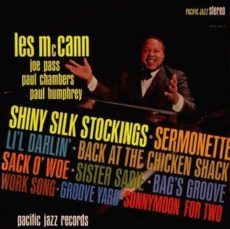
Requisites
Soul Hits ~ Les McCann | By Eddie Carter
In 1972, I was in my senior year at Glenville High School and starting my first year at Cuyahoga Community College’s Metro Campus in Cleveland, Ohio. I studied radio and had an hour-long program titled Edward Carter and All That Jazz playing albums from my library for the students and faculty on school stations, WGHS and WCCC. My goals at that time were to work at Record Rendezvous once I graduated, get my broadcast license, and become a disc jockey at Cleveland’s then jazz station, WCUY 92.3 FM. Sadly, neither of these came to fruition, but I mention it because a few nights ago, I listened to the album that became the inspiration for this morning’s discussion, and it brought back some great memories. Soul Hits (Pacific Jazz PJ-78/ST-78) by pianist Les McCann hit the stores in 1964 and is his ninth record for Richard Bock and Roy Harte’s label. His bandmates are Joe Pass on guitar, Paul Chambers on bass, and Paul Humphrey on drums. My copy used in this report is the original Stereo album.
Jimmy Smith’s Soul-Jazz classic, Back At The Chicken Shack starts Side One at a lively tempo for the quartet’s melody. Joe kicks off the solos swinging easily, then Les gives the next performance a carefree groove ahead of the closing chorus and slow fade. The beat moves upward for Sack O’ Woe by Julian Cannonball Adderley. I first heard it on The Cannonball Adderley Quintet at The Lighthouse. The ensemble crackles with energy on the opening chorus, then Pass swings like mad on an invigorating solo. McCann takes over, fanning the flames with fire on the closing statement into the out-chorus and quick fadeout. Groove Yard is by pianist Carl Perkins and was the song I used to end each radio show with. It’s a very pretty melody that’s a centerpiece for Joe on the melody, reprise, and the respectful grace he demonstrates on the song’s only solo. The trio’s interaction behind him is subtle and beautifully detailed.
Sermonette by Nat Adderley is an infectious tune with an attractive gospel-flavored rhythm by the foursome in unison. The solo order is Pass, Humphrey, and McCann, and each musician preaches an irresistible abbreviated lesson designed to have the listener clap their hands and tap their toes before a soft fade into nothingness. The first side concludes with a brisk workout of Sonnymoon For Two by Sonny Rollins. The quartet’s collective opening chorus is a sheer delight for the ears. Joe is first in the spotlight with an emotionally charged interpretation, then Les performs impressively on a brief closing statement with Chambers and Humphrey providing firm support into the coda.
Milt Jackson’s 1954 standard, Bags’ Groove (pronounced Bag’s Groove here) opens Side Two with McCann opening the song with a spirited statement of optimistic joy. Joe cruises into the melody at a comfortable speed, then the foursome disappears into darkness on a short ending. Shiny Silk Stockings aka Shiny Stockings was written by Frank Foster in 1955 and the quartet treats this young lady to a lovely night on the town with Joe delivering a relaxing theme treatment. Les takes over for a delightfully, dazzling performance preceding the foursome’s reprise and affectionate finale.
The beat moves to mid tempo for Horace Silver’s 1959 standard, Sister Sadie that premiered on Blowin’ The Blues Away that year. The quartet’s rendition is pure fun from first note to last with a danceable beat that compels you to move your feet. Joe is up first and engages the ear with a delightful performance of vivacious licks that’s a pleasure to listen to. Les gets down to business on the second solo with some home cooking that builds nicely into the closing chorus by Paul who executes a flawless interpretation convincingly before the quartet takes the tune out.
The final two tracks on the album are Neal Hefti’s 1957 timeless standard Li’l Darlin’ and Nat Adderley’s contemporary classic Work Song. On Li’l Darlin’, McCann is the featured soloist, and he delivers a deeply thoughtful presentation of warm beauty with Pass providing the perfect punctuation culminating into an intimate ending. Work Song was written in 1960 and is one of Nat Adderley’s finest works as a composer. It’s also the title tune for what many feel is his best studio album. Oscar Brown, Jr. added lyrics to the instrumental and recorded it on his LP, Sin & Soul, making the song a favorite jazz standard among musicians and vocalists around the world. Pass leads the foursome through a very strong opening chorus raising the temperature to a cooking tempo on Joe’s lead solo. Paul’s bass is impeccable on the second reading and Les wraps up the album with a robust exuberance that you can move to.
Richard Bock produced and engineered Soul Hits and the sound is stunning with the incredible definition of each instrument that surrounds your perfect place to listen with sweet sounds throughout the treble, midrange, and low end. The quartet communicates a wonderful sense of delight and sheer pleasure in the music they’re making. Though out of print since the 1981 US reissue by Liberty Records, Soul Hits by Les McCann is an album of great music that’ll delight the fan discovering his music for the first time, the seasoned collector who’s a fan of piano jazz, or if you already own the record as I do, it’ll bring back some great memories!
~ Back at The Chicken Shack (Blue Note BLP 4117/BST 84117); Blowin’ The Blues Away (Blue Note BLP 4017/BST 84017); Sin & Soul (Columbia CL 1577/CS 8377); Soul Hits (Liberty Records LN-10079); The Cannonball Adderley Quintet at The Lighthouse (Riverside RLP 344/RLP 9344); Work Song (Riverside RLP 12-318/RLP-1167) – Source: Discogs.com
~ Shiny Stockings, Li’l Darlin’ – Source: JazzStandards.com
~ Bags’ Groove, Work Song – Source: Wikipedia.org © 2021 by Edward Thomas Carter
More Posts: choice,classic,collectible,collector,history,instrumental,jazz,music,piano
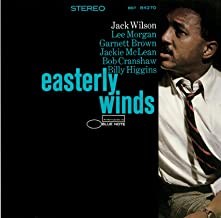
Daily Dose Of Jazz…
Garnett Brown, born January 31, 1936 in Memphis, Tennessee and graduated from the University of Arkansas at Pine Bluff and later studied film scoring and electronic music at University of California Los Angeles. Winning the DownBeat Reader’s poll for trombonists, he appeared on the classic 1976 recording Bobby Bland and B.B. King Together Again…Live.
As a sideman he recorded with Chico Hamilton, Charles Lloyd, Roland Kirk, Art Blakey, Booker Ervin, Lou Donaldson, Teddy Edwards, Frank Foster, Duke Pearson, George Benson, Charles Tolliver, Johnny Hodges, Houston Person, Louis Armstrong, Gene Ammons, Modern Jazz Quartet, Gil Evans, Jackie and Roy, Airto Moreira, Hubert Laws, Dakota Staton, Reuben Wilson, Charles Earland, Don Sebesky, Lou Donaldson, Charles McPherson, Joe Chambers, Yusef Lateef, Jack McDuff, Rusty Bryant, Les McCann, Billy Cobham, Arif Mardin, Herbie Hancock, Charles Tolliver, Richard “Groove” Holmes, Eddie Harris, Horace Silver, Ahmad Jamal, and Gerald Wilson Orchestra of the 80’s among others.
He has worked as a composer in film and television due to his training in the field. In 1989 he was the conductor and orchestrator for Harlem Nights. Trombonist Garnett Brown, having been diagnosed with dementia, he is now retired and living in West Hollywood, California.
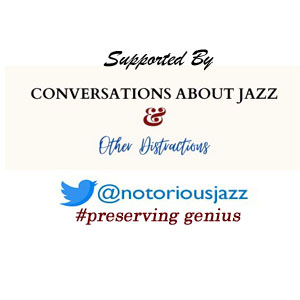
More Posts: history,instrumental,jazz,music,trombone
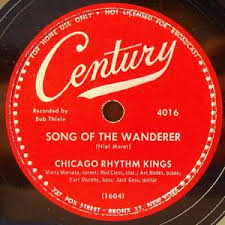
Daily Dose Of Jazz…
Jim Lanigan was born on January 30, 1902 in Chicago, Illinois. Learning piano and violin as a child, he played piano and drums in the Austin High School Blue Friars before specializing on bass and tuba.
A member of the Austin High Gang, he played with Husk O’Hare in1925), the Mound City Blue Blowers and Art Kassel from 1926 to 1927, the Chicago Rhythm Kings, the Jungle Kings, and the 1927 McKenzie and Condon’s Chicagoans recordings.
From 1927 to 1931 he was with Ted Fio Rito and worked in orchestras for radio, including NBC Chicago. Performing sideman duties in the 1930s and 1940s with Jimmy McPartland, Bud Jacobson’s Jungle Kings, Bud Freeman, and Danny Alvin, he began to concentrate more on music outside of jazz at that time. He played with the Chicago Symphony Orchestra from 1937 to 1948, and did extensive work as a studio musician.
Bassist and tubist Jim Lanigan, who never recorded as a leader, played reunion gigs for the Austin High Gang, passed away on April 9, 1983.

More Posts: history,instrumental,jazz,music,tuba
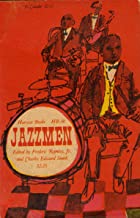
Daily Dose Of Jazz…
Fred Ramsey was born Charles Frederic Ramsey, Jr. on January 29, 1915 in Pittsburgh, Pennsylvania and received his BA at Princeton University in 1936. After graduation he took jobs at Harcourt Brace until 1939, the United States Department of Agriculture from 1941 to 1942, and then with Voice of America.
In 1939 with Charles Edward Smith, he wrote Jazzmen, an early landmark of jazz scholarship particularly noted for its treatment of the life of King Oliver. After receiving Guggenheim fellowships, Fred visited the American South in the middle of the 1950s to make field recordings and do interviews with rural musicians, some of which were used in releases by Folkways Records and in a 1957 documentary, Music of the South.
He curated an anthology of early jazz recordings for Folkways, titled simply Jazz. Ramsey worked with the Institute of Jazz Studies at Rutgers University from 1970. He researched Buddy Bolden’s life with a grant from the National Endowment for the Humanities in 1974–75 and continued with a Ford Foundation grant in 1975–76. He presented early jazz interviews on National Public Radio in 1987.
Writer and record producer Fred Ramsey, who authored six books on jazz, passed away on March 18, 1995 in Paterson, New Jersey.

More Posts: author,history,intrumental,jazz,music,record producer
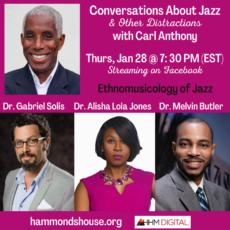
Conversations About Jazz & Other Distractions
Conversations About Jazz Examiness
The Ethnomusicology Of Jazz on January 28
Hammonds House Digital invites you to join us for Conversations About Jazz & Other Distractions hosted by former jazz radio host and founder of Notorious Jazz, Carl Anthony. On Thursday, January 28 at 7:30 pm (EST), Carl’s special guests will discuss Ethnomusicology of Jazz. Tune in for an inspiring evening with noted experts in the field: Dr. Gabriel Solis, Dr. Alisha Lola Jones, and Dr. Melvin Butler. Conversations About Jazz comes out twice a month – on the second and fourth Thursdays. The program is free and will stream on Hammonds House Museum’s Facebook and YouTube channels. For more details about upcoming virtual events, visit hammondshouse.org.
Ethnomusicology is the study of music in its social and cultural contexts. Ethnomusicologists examine music as a social process, to understand not only what music is but what it means to its practitioners and audiences. Individuals working in the field of ethnomusicology may have training in music, cultural anthropology, folklore, performance studies, dance, area cultural studies, gender studies, race or ethnic studies, or other fields in the humanities and social sciences.
A scholar of African American music and of Indigenous musics of the Southwestern Pacific, Dr. Gabriel Solis has done ethnographic and historical research with jazz musicians in the United States and with musicians in Australia and Papua New Guinea. Drawing on work in African American studies, anthropology, and history, he addresses the ways people engage the past, performing history and memory through music. He has received the Wenner Gren Foundation’s Hunt Fellowship, the Arnold O. Beckman Fellowship for distinguished research, the Madden Fellowship for research in technology and the arts, an Illinois Program for Research in the Humanities fellowship, and most recently a Unit for Criticism and Interpretive Theory senior fellowship. He is Professor of Musicology at the School of Music, University of Illinois at Urbana-Champaign.
Alisha Lola Jones, PhD is an Assistant Professor in the Department of Folklore and Ethnomusicology at Indiana University (Bloomington). Dr. Jones is a graduate of University of Chicago (Ph.D.), Yale Divinity School (M.Div.), Yale Institute of Sacred Music (ISM) and Oberlin Conservatory (B.M.). Dr. Jones’ is a council member of the Society for Ethnomusicology’s (SEM) council and the co-chair of the Music and Religion section of the American Academy of Religion (AAR). Additionally, as a performer-scholar, she consults seminaries and arts organizations on curriculum, programming, and content development.
Dr. Melvin Butler is an Associate Professor in the Department of Musicology at the Frost School of Music, University of Miami. He specializes in music and religion in Haitian, Jamaican, and African American communities. Dr. Butler’s research explores the cultural politics of musical performance, national identity, and extraordinary experience. He also examines the discourses of cultural authenticity and spiritual power that inflect congregational practice. At the heart of his scholarly work lies a critical reconsideration of how spiritually charged music-making is embedded in processes of boundary crossing, identity formation, and social positioning throughout the African diaspora.
Hammonds House Museum is generously supported by the Fulton County Board of Commissioners, Fulton County Arts and Culture, the City of Atlanta Mayor’s Office of Cultural Affairs, The Community Foundation for Greater Atlanta, The National Performance Network, AT&T and WarnerMedia.
Hammonds House Museum’s mission is to celebrate and share the cultural diversity and important legacy of artists of African descent. The museum is the former residence of the late Dr. Otis Thrash Hammonds, a prominent Atlanta physician and a passionate arts patron. A 501(c)3 organization which opened in 1988, Hammonds House Museum boasts a permanent collection of more than 450 works including art by Romare Bearden, Robert S. Duncanson, Benny Andrews, Elizabeth Catlett, Jacob Lawrence, Hale Woodruff, Amalia Amaki, Radcliffe Bailey and Kojo Griffin. In addition to featuring art from their collection, the museum offers new exhibitions, artist talks, workshops, concerts, poetry readings, arts education programs, and other cultural events throughout the year.
Located in a beautiful Victorian home in Atlanta’s historic West End, Hammonds House Museum is a cultural treasure and a unique venue. During the COVID-19 pandemic, they continue to observe CDC guidelines, but look forward to welcoming in-person visitors soon! For more information about upcoming virtual events, and to see how you can support their mission and programming, visit their website: hammondshouse.org.
MEDIA: For more information, contact Karen Hatchett at Hatchett PR, karen@hatchettpr.com
More Posts: conversations,educators,ethnomusicology,history,instrumental,jazz,musicians


